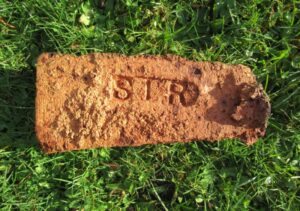Found by Ian Suddaby in High Bonnybridge, Bonnybridge.
This example is not in my possession.
The manufacturer is unknown.
The find location would suggest this is a Scottish product and manufactured by one of several fire brick makers in the area for the Indian Railways.
It is possible that SIR may stand for South Indian Railway – On 1st July 1874 the Great Southern of India Railway Company (GSIR) and the Carnatic Railway, were amalgamated under the title of the South Indian Railway.
At the time of amalgamation, the GSIR had constructed a broad gauge (BG) line from Negapatam to Trichinopoly and on to Erode where it connected to the Madras Railway and the Carnatic Railway had constructed a metre gauge (MG) line from Arkonam Junction to Conjeeveram.
From 1875 the originally constructed BG lines were converted to MG in order to have a seamless flow of traffic since all the other lines around Trichinopoly were MG. The Negapatam to Trichinopoly section converted in 1875 and to Erode by the end of 1879.
The construction of the Pondicherry Railway in French territory by the SIR commenced in 1878 simultaneously with a SIR branch, so when opened in 1879 connected Pondicherry to the SIR mainline at Villupuram. The line was maintained and worked by the SIR under the management of the SIR Agent which had remained at the original Negapatam. The joint Agent finally moved to Trichinopoly in 1880.
Ownership of the SIR and other lines passed to the Government of India (GoI) on 31 December 1890 and a new company, ‘ The South Indian Railway Company Limited’ was formed to work the system so created under contract; this contract was extended in 1909.
The year previously (1908), the Jalarpet to Mangalore broad gauge section had been transferred to the SIR from the Madras Railway. In turn, the Katpadi section was relinquished and became part of the newly formed Madras and Southern Mahratta Railway.
On 1 April 1944, the GoI took over direct control of the SIR.
In 1951, the SIR became a constituent part of ‘Southern Railway’, a zone of Indian Railways.
Source WIKI











